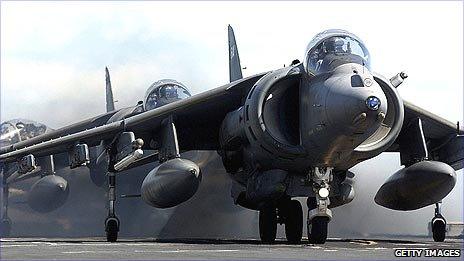A modern military icon
- Published

The iconic Harrier Jump Jet, set to be axed from next year under spending cuts, came to be a proud example of British excellence in engineering and military ingenuity, says Gary Eason.
It has served Britain with distinction and holds that rare position of being one of the few military aircraft that the average person on the street can name. The Harrier Jump Jet is iconic.
Capable of vertical takeoff and landing, it has been a formidable weapon and was vital in winning the Falklands War. It has also been essential more recently in Afghanistan.
It's also responsible for bringing some weird language into relatively common parlance: VTOL (vertical take-off and landing), VSTOL (vertical/short take-off and landing) and STOVL (short take-off and vertical landing)
Also, during the Falklands War, there was VIFFing. This technique - which may owe more to comic book gung-ho than military fact - refers to "vectoring in forward flight" - basically allowing for remarkably tight turns.
What is certain is that the Harrier is unique in being a fast jet with a serious military punch, that can take off and land vertically.
It is perhaps also thought of as a uniquely British thing, developed by Hawker Siddeley at a time when the British were still very good at that sort of engineering. There is one currently hanging in Tate Britain, an extraordinarily poignant, somehow almost mammalian-looking thing.
In fact the idea behind it is French and it's the product of international collaboration. Various designs for vertical take-off and landing aircraft were being tossed about in the 1950s, but the idea of four rotating nozzles channelling the thrust off a single engine came from Frenchman Michel Wibault.
Unconventional
He approached the French and American governments unsuccessfully, before being directed by a Nato office in Paris - which put up development funding - to Bristol Aero-Engines in England.
There Gordon Lewis took the swivelling nozzles concept, applied it to a jet engine and made it a practical proposition, according to Chris Farara, who joined the flight development team as a new graduate in 1960.
The airframe that pulled the whole package together was designed by Ralph Hooper of Hawker Aircraft in Surrey, now part of BAE Systems.
John Farley first flew the P1127 prototype in 1964, while a test pilot at the Royal Aircraft Establishment.
"Every time I got out I used to climb down the ladder and say 'thank god I didn't break it'," he says.
One of the biggest problems was that, at low speed, the aircraft's normal flight controls are useless. So it uses what is called a reaction control system - air bled from the engine into nozzles in the nose, tail and wingtips.
On a point of principle, Hawker had decided it was going to require the pilots to learn how to operate this unconventional system rather than try to build in complex and unreliable auto-stabilisers. But also, the original engine was under-powered.
"It had to be thrashed to provide the thrust to hover," says Mr Farley.
As a result it had to be taken out and rebuilt after just one hour of hovering and 20 hours of normal flight - at £60,000 a pop. So practising hovering was a luxury they could not afford.
"You were paying £1,000-a-minute direct engine depreciation," says Mr Farley. "It required all the skill that I could bring to bear in terms of handling the aeroplane. That's what test flying was like in the 1960s - there were no simulators."
'Black death'
The British, American and German governments agreed to build nine aircraft and an international squadron was formed - nominally part of the RAF - which proved its military potential. Things got sidetracked somewhat by a Nato requirement for a supersonic version, which ultimately never came about.
In the UK, RAF and Navy rivalries - which were nothing new - muddied the water further, until ultimately the Navy pulled out and the RAF went ahead with what became the Harrier.

The jets can takeoff vertically
And, in spite of American reservations about buying any military hardware that is not US-built, the US Marine Corps ordered more than 100. The American demand for a bigger, more capable version was a key driver behind the Harrier II (known in the US as the AV-8B), developed with McDonnell Douglas.
To date there have been some 30 variants of the original Harrier, used by armed forces in the UK, America, Italy, Spain, India and Thailand.
But for most people the Harrier only really came into the public consciousness in the Falklands conflict in 1982. It was used to fight off Argentine aircraft and to bomb enemy positions ashore. It is said the aircraft's capability, along with the skill of its pilots, gave the British the edge in the conflict.
The Harriers shot down at least 20 enemy aircraft without a single combat loss in return and were nicknamed the "black death" by Argentine pilots.
Reporting on the conflict at the time, BBC journalist Brian Hanrahan was restricted from revealing aircraft numbers during battle. But in one morning alone 15 Harriers sortied and returned, giving rise to his often-quoted words: "I counted them all out, and I counted them all back.''
Mr Farara, of the Hawker Association, made up of those who worked for the company, thinks it sad that the UK's deployment is ending.
"But it's had a good run."
Mr Farley last flew one in 1999. It was a fly-by-wire experimental craft to prove systems for the US-British Joint Strike Fighter that will ultimately replace it. The new craft was very different from the thing he grappled to control almost 50 years ago.
He says the Harrier's demise says more about the UK than it does about the jet, which is still regarded very highly in other countries. He thinks the British may regret not having the flexibility it provides.
"I think we've blown it," he says. "I find it pathetic."